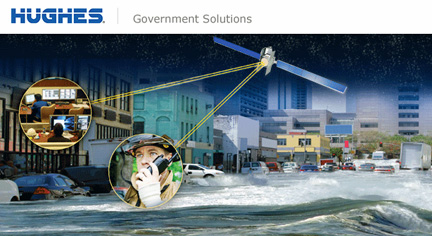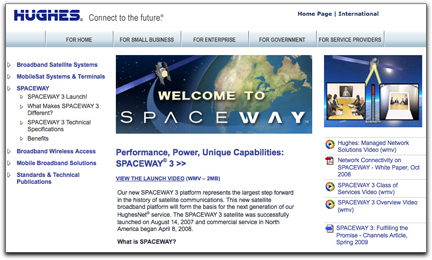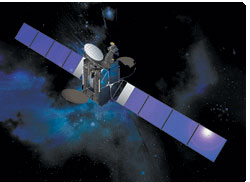 [SatNews] Hughes Network Systems, LLC (HUGHES) has now made available the new Hughes Emergency Services just as the 2013 hurricane season begins. Hughes Emergency Services include satellite network solutions for emergency preparedness, restoral, and post-event response designed to provide robust, expedited broadband Internet connectivity for government and business when a disaster strikes. Powered by the SPACEWAY© 3 Ka-band satellite system or the new EchoStar XVII® satellite with JUPITER™ high-throughput technology, users can get speeds up to 15Mbps.
[SatNews] Hughes Network Systems, LLC (HUGHES) has now made available the new Hughes Emergency Services just as the 2013 hurricane season begins. Hughes Emergency Services include satellite network solutions for emergency preparedness, restoral, and post-event response designed to provide robust, expedited broadband Internet connectivity for government and business when a disaster strikes. Powered by the SPACEWAY© 3 Ka-band satellite system or the new EchoStar XVII® satellite with JUPITER™ high-throughput technology, users can get speeds up to 15Mbps.
 According to the National Hurricane Center, Hurricane Sandy was the largest Atlantic hurricane recorded in history and the second most expensive after Hurricane Katrina. Hurricane Sandy destroyed parts of the Caribbean, Mid-Atlantic, and Northeastern United States, causing approximately $20 billion in damage and an estimated loss of $50 billion in revenue from interruption to businesses.[1] This year, meteorologists are predicting an above-average probability for major hurricanes making landfall in the Atlantic Basin including the Caribbean Sea, the Gulf of Mexico, and along the U.S. coastline.[2]
According to the National Hurricane Center, Hurricane Sandy was the largest Atlantic hurricane recorded in history and the second most expensive after Hurricane Katrina. Hurricane Sandy destroyed parts of the Caribbean, Mid-Atlantic, and Northeastern United States, causing approximately $20 billion in damage and an estimated loss of $50 billion in revenue from interruption to businesses.[1] This year, meteorologists are predicting an above-average probability for major hurricanes making landfall in the Atlantic Basin including the Caribbean Sea, the Gulf of Mexico, and along the U.S. coastline.[2]
“In the aftermath of Hurricane Sandy, terrestrial and wireless networks failed or were unreliable while satellite technology proved invaluable to businesses, government, and non-profits in meeting their Internet and voice connectivity needs,” said Mike Cook, senior vice president at Hughes. “With the memory of Hurricane Sandy’s impact still fresh in our minds, it is critical that organizations think proactively about emergency communications preparedness. At some point, there will be another hurricane. Terrestrial networks will fail and cell phone tower backup generators will lose power, but if businesses, non-profits, and government agencies incorporate satellite technology into their emergency communications plans, they will be able to ensure continuity of communications to support their operations during and immediately following disasters. Hughes is ready to help with trusted, proactive path-diverse satellite technology and emergency restorable solutions, as well as emergency response satellite broadband Internet service.”

Artistic rendition of the
EchoStar VII satellite.
- Subscribe to a resilient, high-speed network service, such as satellite broadband, so that decision-makers and emergency operators can stay connected even if terrestrial networks fail
- Prepare and protect critical data. Evaluate which applications and information systems are essential. This can include Continuity of Operations (COOP) and emergency response plans, accounting documents, inventory logs, and constituent information. Organizations should back-up information frequently and store the data in a safe, secure, and dependable facility. As data may be lost due to flooding, consider storing it at an off-site location
- Do not hesitate to go on alert. If a facility is at risk of losing service for an extended period of time, put its Web host provider on alert
Landline connections can be unreliable during significant flooding and windy conditions, forcing operations to cease. This can mean a significant loss of revenue for businesses and disruption of vital government and non-profit services that are needed most in recovery operations. Whether an organization needs emergency communications at a fixed site or on-the-move, Hughes can deliver reliable connections during crisis.
“We learned firsthand the value of satellite broadband service in the days, weeks, and months following Hurricane Sandy,” said Jim Killoran, executive director of Habitat for Humanity of Westchester, New York. “The storm destroyed over 120 homes in New York’s Breezy Point area and knocked out landlines. Cell phone coverage was completely unreliable. Hughes satellite technology was the only thing that worked, and we used it—and continue to use it—to coordinate rebuilding efforts.”
Hughes offers three solutions to ensure uninterrupted communications connectivity in the wake of a hurricane.
- Hughes Emergency Response Solutions. Designed to provide satellite broadband Internet for emergency response and recovery scenarios—even in the most remote locations. Powered by the SPACEWAY 3 Ka-band satellite system or EchoStar XVII satellite with JUPITER high-throughput technology—a next generation Ka-band satellite system, the solutions provide the industry’s fastest satellite Internet speeds, up to 15 Mbps
- Hughes Continuity of Operations (COOP) Solutions. Designed for emergency communications preparedness, these path-diverse solutions provide Internet connectivity when terrestrial or wireless primary networks fail. Hughes pre-positions a permanent terminal at a designated location. Featuring policy-based routing with automatic failure detection and switchover between primary and backup links, the solutions complement existing primary networks with 99.99 percent availability. Hughes COOP Solutions are powered by the SPACEWAY 3 or EchoStar XVII
- Hughes Emergency Network Restoral (ENR) Solutions. The ENR Solution blends pre-disaster planning and set up with rapid post-event deployment. It offers a completely diverse Virtual Private Network (VPN) backup service for locations connected by Wide Area Networks (WAN). Hughes designs, pilots, configures, and integrates a private satellite network with a WAN. After an emergency occurs, Hughes ENR Solutions ensure communications restoral within 48 hours using standard VSAT equipment
Every solution is backed by comprehensive 24/7 technical support and next-business day field maintenance.

